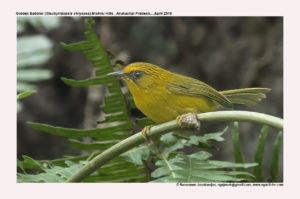
Golden Babbler Stachyridopsis chrysaea.
Etymology:
- Stachyridopsis : Greek word stakhus -ear of wheat; rhis -nostrils;opsis- Appearance { reference to the shape of the opercula or scales almost closing the nostrils}
- Chrysaea: Greek word khruseios –golden derived from khrusos – gold.
Vernacular Names: Lepcha: Syak-birang-pho, Mishmi: Pra-li-ne, Pe-ma-ra
Distribution in India: Resident of Himalayas and hills of North East India.
Description: Size of 10–12 cm; Wt. of 6–10 g. It is a distinctive small babbler with narrowly striped crown, black half-mask and yellow underparts. The nominate race has golden-yellow on crown and nape, narrowly and evenly streaked with black, with strong yellow preocular lateral crown stripe bordering black on lores and short black supercilium. The upperparts are yellowish-olive, upperwing and tail are brownish-grey, flight-feathers are with narrow yellow-buff fringes. It has short black submoustachial stripe from lores, plain yellowish-olive ear-coverts; chin to mid-belly are bright yellow, shading on sides and below to olive-yellow. The iris is red or red-brown to brown or brown-grey; bill is blackish, paler below, often with pinkish-red or pinkish-flesh base of lower mandible. The legs are pale yellowish-brown to light brown. Both the sexes are similar. The juvenile is duller and browner above than adult, whiter below, with browner flanks. Race binghami is more greyish-olive above than nominate, weaker yellow below, ear-coverts dark grey.
Habitat: It is found in broadleaf evergreen forest, bamboo stands, also dense bushes, thickets, deserted cultivation and clearings; secondary forest, pine forest and upper montane primary vegetation. It is found at 300–3000 m.
Food habits: It eats Insects like ants, caterpillars and berries. It forages in lower to middle storeys. In non-breeding season found in family flocks or mixed flocks with Old World warblers and other species of babbler like grey-throated babbler.
Breeding habits: They breed in Jan–Jul. The nest is a dome or ball with entrance near top, made of dry bamboo or other leaves and pine needles, lined with rootlets, placed on ground among dead leaves, on bank, in bamboo clump or bush or suspended from pine branch in foliage above ground. They lay a clutch of 3–4 eggs.